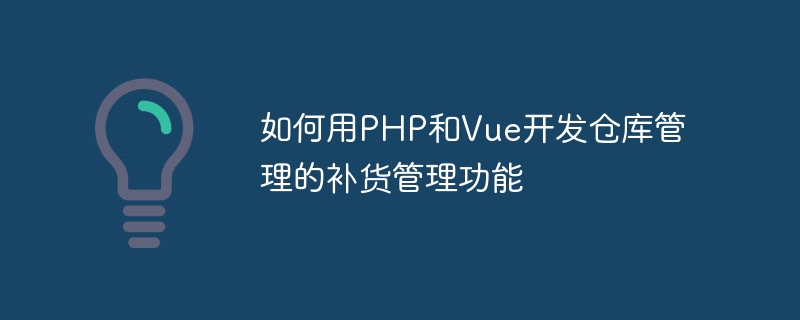如何用PHP和Vue開發倉庫管理的補貨管理功能
- WBOYWBOYWBOYWBOYWBOYWBOYWBOYWBOYWBOYWBOYWBOYWBOYWB原創
- 2023-09-26 14:13:57822瀏覽

如何以PHP和Vue開發倉庫管理的補貨管理功能
在現代商業運作中,倉庫管理是非常重要的環節之一。對於倉庫來說,補貨管理功能可以確保及時補充庫存,以滿足客戶需求,並且避免物品短缺的情況發生。在本文中,我們將探討如何使用PHP和Vue開發一個倉庫管理系統的補貨管理功能,並提供具體程式碼範例。
一、技術選型
為了實現補貨管理功能,我們選擇使用PHP作為後端語言,Vue作為前端框架。 PHP是一種強大且靈活的後端開發語言,而Vue則是用來建立使用者介面的漸進式JavaScript框架。透過這樣的技術選型,我們可以輕鬆地實現前後端分離,並且使專案的開發更加高效和可維護。
二、後端開發
- 環境建置
#首先,我們需要建構PHP的開發環境。可以使用XAMPP或WAMP等整合開發環境來建構一個本地的PHP開發環境。確保你已經安裝了PHP和資料庫(如MySQL)。
- 建立資料庫
在MySQL中建立一個名為"warehouse_management"的資料庫,並建立兩個表格:"products"和"replenishments"。 "products"表格用於儲存商品資訊,而"replenishments"表格用於儲存補貨記錄。
products表格的欄位包括:id、name、quantity。
replenishments表格的欄位包括:id、product_id、quantity、date。
- 寫API
在PHP中,我們可以使用PDO(PHP Data Objects)來與資料庫互動。首先,我們需要建立一個連接到資料庫的文件,例如db.php:
<?php
$servername = "localhost";
$username = "your_username";
$password = "your_password";
$dbname = "warehouse_management";
try {
$conn = new PDO("mysql:host=$servername;dbname=$dbname", $username, $password);
$conn->setAttribute(PDO::ATTR_ERRMODE, PDO::ERRMODE_EXCEPTION);
} catch(PDOException $e) {
echo "Connection failed: " . $e->getMessage();
}
?>然後,我們可以編寫API來處理前端請求。例如,我們可以建立一個名為"getProducts.php"的檔案來取得所有商品的資訊:
<?php
require_once('db.php');
try {
$stmt = $conn->prepare("SELECT * FROM products");
$stmt->execute();
$results = $stmt->fetchAll(PDO::FETCH_ASSOC);
echo json_encode($results);
} catch(PDOException $e) {
echo "Error: " . $e->getMessage();
}
?>相同的,我們可以建立一個"addReplenishment.php"的檔案來新增補貨記錄:
<?php
require_once('db.php');
$product_id = $_POST['product_id'];
$quantity = $_POST['quantity'];
try {
$stmt = $conn->prepare("INSERT INTO replenishments (product_id, quantity, date) VALUES (:product_id, :quantity, NOW())");
$stmt->bindParam(':product_id', $product_id);
$stmt->bindParam(':quantity', $quantity);
$stmt->execute();
echo "Replenishment added successfully";
} catch(PDOException $e) {
echo "Error: " . $e->getMessage();
}
?>三、前端開發
- 環境建置
#對於前端開發,我們需要安裝Node.js以及Vue CLI。可以在Node.js的官網下載安裝程序,並執行以下命令安裝Vue CLI:
npm install -g @vue/cli
- 建立Vue專案
vue create warehouse-management然後,我們可以選擇一些選項來配置專案。在這個過程中,我們可以選擇使用Babel和Router,並選擇"Manually select features",然後按下回車鍵繼續。
- 編寫元件和API呼叫
<template>
<div>
<h2>Product List</h2>
<table>
<thead>
<tr>
<th>ID</th>
<th>Name</th>
<th>Quantity</th>
</tr>
</thead>
<tbody>
<tr v-for="product in products" :key="product.id">
<td>{{ product.id }}</td>
<td>{{ product.name }}</td>
<td>{{ product.quantity }}</td>
</tr>
</tbody>
</table>
</div>
</template>
<script>
export default {
data() {
return {
products: []
};
},
mounted() {
this.getProducts();
},
methods: {
getProducts() {
fetch('http://localhost/api/getProducts.php')
.then(response => response.json())
.then(data => {
this.products = data;
});
}
}
};
</script>然後,我們可以建立一個用於新增補貨記錄的元件(AddReplenishment.vue):<template>
<div>
<h2>Add Replenishment</h2>
<form @submit.prevent="addReplenishment">
<label for="product">Product:</label>
<select name="product" v-model="product_id">
<option v-for="product in products" :value="product.id" :key="product.id">{{ product.name }}</option>
</select>
<br>
<label for="quantity">Quantity:</label>
<input type="number" name="quantity" v-model="quantity" required>
<br>
<button type="submit">Add</button>
</form>
</div>
</template>
<script>
export default {
data() {
return {
products: [],
product_id: '',
quantity: ''
};
},
mounted() {
this.getProducts();
},
methods: {
getProducts() {
fetch('http://localhost/api/getProducts.php')
.then(response => response.json())
.then(data => {
this.products = data;
});
},
addReplenishment() {
fetch('http://localhost/api/addReplenishment.php', {
method: 'POST',
headers: {
'Content-Type': 'application/x-www-form-urlencoded'
},
body: `product_id=${this.product_id}&quantity=${this.quantity}`
})
.then(response => response.text())
.then(data => {
console.log(data);
// Refresh product list
this.getProducts();
// Reset form values
this.product_id = '';
this.quantity = '';
});
}
}
};
</script>
- 整合元件
<template>
<div id="app">
<ProductList />
<AddReplenishment />
</div>
</template>
<script>
import ProductList from './components/ProductList.vue';
import AddReplenishment from './components/AddReplenishment.vue';
export default {
name: 'App',
components: {
ProductList,
AddReplenishment
}
};
</script>至此,我們已經完成了基於PHP和Vue的倉庫管理系統的補貨管理功能的發展。 總結在本文中,我們介紹如何使用PHP和Vue開發一個倉庫管理系統的補貨管理功能。透過選擇合適的技術,我們可以有效率地開發一個可靠且易於維護的系統。希望本文能為您進行相關開發工作提供一些協助。 以上是如何用PHP和Vue開發倉庫管理的補貨管理功能的詳細內容。更多資訊請關注PHP中文網其他相關文章!

